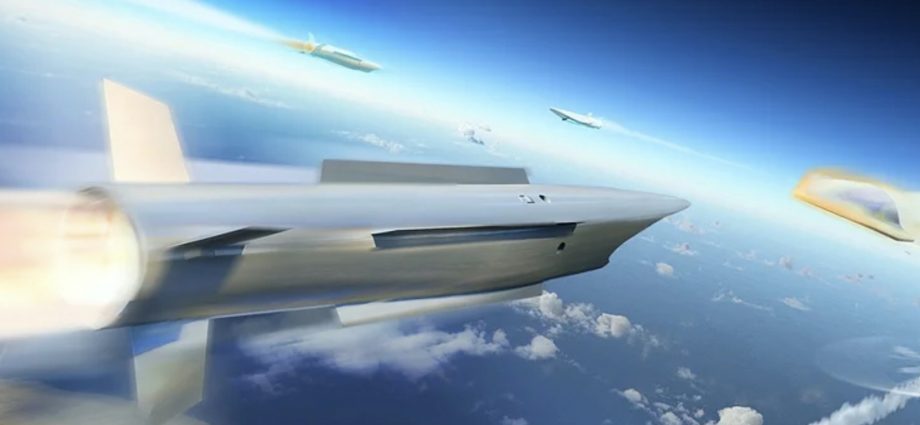German and Spanish missile manufacturers jointly aim to develop a hypersonic missile interceptor, a move that will seek to modernize wider Europe’s missile defenses against emerging new Russian threats.
The European Hypersonic Defense Interceptor (EU HYDEF) project will cover the concept phase to develop a so-called endo-atmospheric interceptor, which will aim to cover threats from 2035 and beyond.
It will run for 36 months at a projected cost of US$110 million, with the EU contributing almost $100 million to the effort.
Defense News reports that the program’s goal is to field a countermeasure that can eventually be integrated into existing air defense systems capable of early warning, tracking and interception of current and future airborne threats including ballistic and hypersonic missiles.
The same report mentions that Germany’s Diehl Defense will serve as the project’s technical lead, while Spain’s Sener Aerospacial Sociedad Anonima will coordinate the effort.
Both companies work closely with the IRIS-T surface-to-air missile system, emphasizing the strong working relationship between the two defense firms.

Diehl will be responsible for the interceptor system’s engineering and design, upstage design and system simulation, upstage guidance, navigation and control, seeker head and signal electronics, according to the same report.
At the same time, Sener will lead work on guidance, navigation and control (GNC) systems, along with communications, actuators and aerodynamic control.
Sener, in a statement, mentioned that the project “will result in the concept, risk reduction and demonstration of an efficient endo-atmospheric interceptor capable of operating at different flight levels, which will include an innovative aerodynamic control system for high maneuverability, very agile guiding concepts and advanced sensor and search systems.”
It added that the EU HYDEF project will involve 13 companies and organizations from seven European nations, namely Spain, Germany, Belgium, Norway, Czech Republic, Poland and Sweden.
Sener also said that the EU HYDEF project is related to the French-led Permanent Structured Cooperation (PESCO)’s Timely Warning and Interception with Space-based TheatER Surveillance (TWISTER) project, which aims to develop a complete system to defend against hypersonic threats via space-based surveillance.
This March, Russia became the first to use hypersonic weapons in combat when it fired a Kinzhal air-launched hypersonic missile at a Ukrainian underground weapons storage facility.
In an article for The Strategist, senior researcher Azriel Bermant notes that it is difficult to calculate the trajectory of a high-velocity and maneuverable missile such as the Kinzhal due to its built-in unpredictability.
However, Bermant reports that defenders can still shoot down such missiles with an equally-maneuverable interceptor missile.
With Russia’s maiden use of its Kinzhal hypersonic weapon in Ukraine, NATO’s existing missile defense systems, namely the Patriot and Aegis Ashore, now look vulnerable to a similar Russian attack.

Asia Times has reported on the possible limitations of these systems, which include target identification issues with Patriot, and the limited effectiveness of both Patriot and Aegis Ashore against highly-lofted trajectory ballistic missile attacks.
Those weaknesses may have spurred European states to upgrade their existing missile defense systems to better defend against hypersonic threats. The US is moving in a similar direction.
Last month, Asia Times reported that the US is wrapping up tests of its Long-Range Discrimination Radar (LRDR), a two-in-one system capable of tracking multiple space threats and identifying warheads from decoys.
Apart from this new radar system, Asia Times reported that the US plans to develop a new two-tier satellite missile tracking system, in a fundamental shift to the concept of its space-based missile defense sensors. US space-based missile defense currently relies on a few large and expensive satellites that stay in orbit for 15 or more years.
The US aims to replace this legacy system with a two-tiered satellite constellation operating in low-earth (LEO) orbit at 1,000 kilometers and medium-earth orbit (MEO) at 10,000 to 20,000 kilometers, using cheaper satellites replaced every five years.
Despite these US missile sensor network improvements, they may ultimately be of marginal value without an effective interceptor against hypersonic threats.
Asia Times has reported on the low success rate of the US’ Ground-Based Midcourse Defense, which stands at just 53%. By any strategic measure, that’s too low for the only defense system against missile threats targeting the US homeland.
Asia Times has also noted the limited effectiveness of the US’ workhorse SM-6 Standard interceptor missile against hypersonic threats, mentioning that its latest variant, the SM-6 Dual, has questionable capability against maneuvering targets flying at hypersonic speeds.

A 2021 study by the Italy-based think tank Istituto Affari Internazionali notes that Europe’s missile defense is structurally linked to NATO deterrence and that the US remains the leader in fielding the Aegis and Patriot systems that remain the cornerstone of NATO’s air and missile defenses.
It also noted that European countries are increasingly cooperating on missile defense through the TWISTER project.
While Europe may maintain certain strategic autonomy by pursuing the HYDEF and TWISTER projects, it will also need to ensure integration with NATO while mobilizing its defense industries with a particular focus on technology-sharing and cutting-edge R&D for missile defense.

